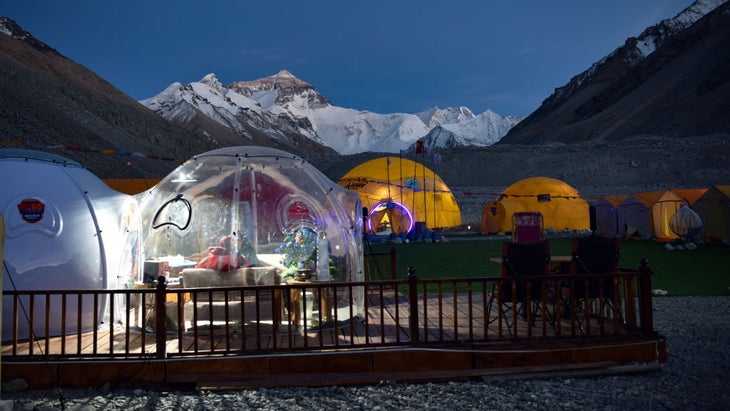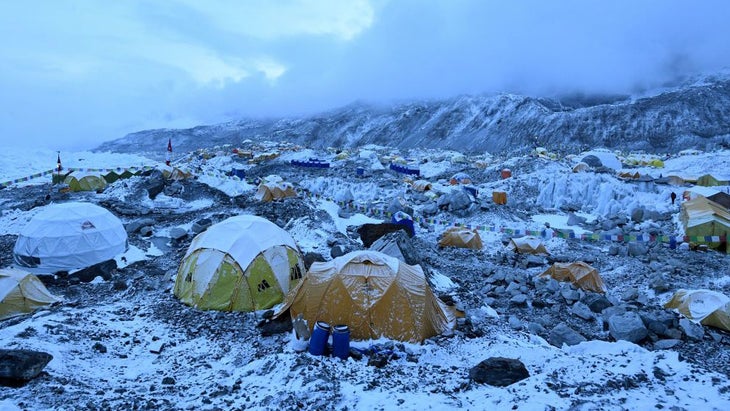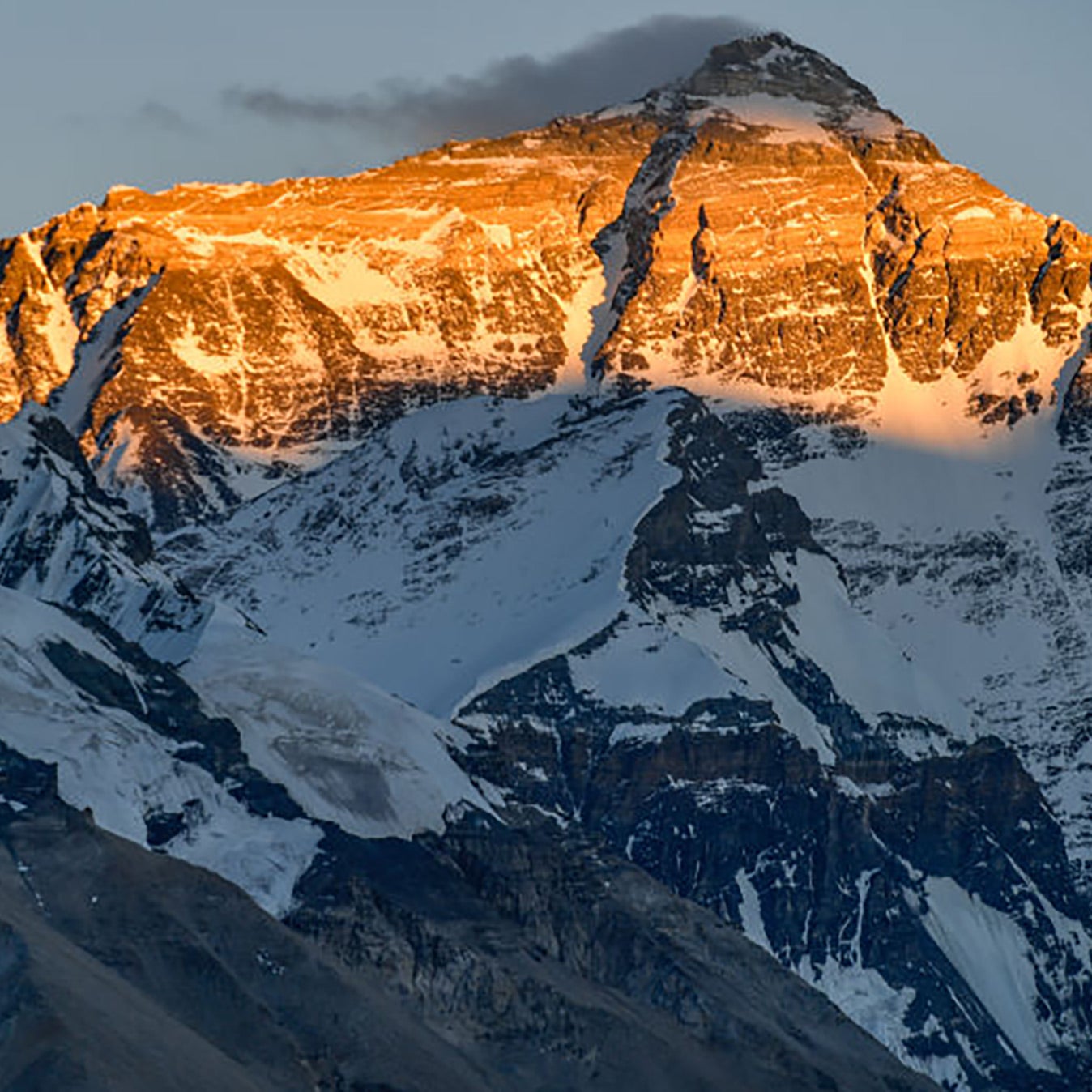The 2024 climbing season on Mount Everest is in full swing this week as some expedition teams are arriving at Base Camp and others have begun acclimatization rotations on the peak. As Outside recently reported, the official start on the mountain’s Nepali side is delayed this year due to dangerous conditions in the Khumbu Icefall. The circuitous route through the glacier that precedes the easier climbing up to Camp I and Camp II is longer than the one used in previous years, due to an unusually dry winter and a lack of snowfall.
The scheduling delay and new route aren’t the only dynamics impacting expeditions on the world’s highest peak this year. Competition from China has drawn some climbing teams away from the southern Base Camp in Nepal. And new rules and regulations imposed by the Nepali government will shift how some teams handle safety, decorum in Base Camp, and even poop.
Climbers may encounter slightly fewer of their peers along the route to the top, as recent statements from officials in Nepal hint at a smaller crowd than in recent years. According to Rakesh Gurung, Director of Nepal’s department of tourism, the country expects to issue approximately 400 climbing permits for the season—down from the record-breaking 478 last year. As of April 22, 365 permits had been granted to 34 different expedition teams. Permits for three additional teams are still being processed, Gurung said.
“Climbing permits are down across all the peaks,” Gurung said. “One reason is the global economic situation, and another is that China is open for Everest permits this year.”
China Attracts Summit Seekers

Indeed, China has once again opened its borders to Everest climbers in 2024 following a four-year closure due to Covid. Unlike the Nepali Base Camp, the Chinese Base Camp can be accessed by car, making the transport there much easier. Some expedition operators prefer to climb from the Chinese side, claiming that Everest’s Northeast ridge is less vulnerable to avalanches and rockfall than the southern flank. The smaller crowds on the Chinese side present another advantage.
But there’s a drawback in climbing from China—currently, the government has yet to issue the final permits to Everest expeditions, or even allow climbers into the country. Just this week officials told expedition operators that they would be allowed to enter the country on May 7—significantly later than originally planned.
“Thankfully the north side doesn’t have the same end-of-season issues that the south side does,” Adrian Ballinger, CEO of Alpenglow Expeditions, told Outside. “Tibet is in the rain shadow of Everest and the monsoon is generally much later. It’s not our ideal, but everyone is doing their best and that’s our plan.”
The Everest delay is just one curveball facing climbers in China. The country recently canceled all climbing on 26,335-foot Shishapangma and 26,864-foot Cho Oyu.
The uncertainty prompted Seven Summits Treks, Nepal’s largest Everest operator, to cancel its Chinese Everest expedition altogether, moving all eight of its clients to climb in Nepal. “We have had clients waiting here [in Kathmandu] for 15 days, and our Shishapangma clients have been waiting since April 5th,” said Thaneswhar Guragai, the company’s general manager.
The cancellation of permits on Cho Oyu and Shishapangma presents a significant setback for climbers hoping to complete all 14 peaks above 8,000 meters this year, and two well-publicized expeditions hoping to retrieve the bodies of four victims of an avalanche last October. The deceased are American climbers Anna Gutu and Gina Marie Rzucidlo, along with their guides Mingmar Sherpa and Tenjen ‘Lama’ Sherpa. Two months before the avalanche, ‘Lama’ earned the speed record for climbing all 14 8,000-meter peaks in 92 days, along with Norwegian climber Kristin Harila.
New Rules in Nepal

A record number of Everest fatalities in 2023, combined with the mounting pollution on the peak, prompted Nepali officials to enact new regulations governing expeditions. The regulations oversee a wide swath of operations, from climber safety to the size of tents allowed in Base Camp. The most cumbersome rule may be the new mandate that all climbers must carry their human waste down off the mountain in biodegradable bags and deposit it at a collection center at Base Camp.
The local government body that oversees the Everest region, the Khumbu Pasang Lhamu Rural Municipality, is responsible for this program. According to Jagat Prasad Bhusal, the organization’s chief administrative officer, officials are still debating what, exactly, to do with all of that poop.
“We are currently exploring options for handling the feces. If feasible, we will either convert it into manure or dispose of it safely near Tengboche or Pangboche in Upper Khumbu,” he said.
Expedition operators who spoke to Outside expressed positive sentiment toward the poop rule, despite the logistical challenges it presents. “This will be beneficial in the future because the whole world is looking towards sustainability. A small contribution to help the mountain is never a bad idea.” Guragai said.
Another new rule requires climbers to wear RECCO-style tracking reflectors during their climbs. In theory, this technology allows rescuers to find lost climbers by using a specialized transponder that tracks the reflectors. But there are doubts this will work in Everest’s extreme altitude and vast terrain. “We don’t know how well it will work,” Gurung told Outside “But let’s try.”
Gurung said Nepali officials are planning to make GPS tracking mandatory in future seasons. The devices will improve safety, he said. “This will also reduce false summits,” Gurung added.
To enforce these new rules, Nepal’s department of tourism has opened a field office at Base Camp. Officials stationed there will make sure expeditions follow the regulations, and they will also teach climbers lessons on mountain safety and “expedition ethics,” Gurung said.
“The rules and regulations are one thing. But people have to be aware of their own abilities, too,” Gurung said. “If something happens at 8,000 meters, a rescue is basically impossible. If expedition ethics are followed in these situations, the number of casualties will be reduced greatly.”
Despite the new regulations and the slight downturn in climbing permits, officials still expect the route to become crowded. Advanced weather forecasting means most expedition operators head onto the peak at the same time to take advantage of clear skies. And many expedition operators send as many, or more, guides onto the peak as paying clients.
An estimated 1,500 porters, guides, and Sherpas will be working above Base Camp to build camps and ferry gear, and the total number of climbers heading for the summit from both sides is likely to surpass 700, officials said.
Gurung told Outside that officials will examine the 2024 season to see if the government should make additional changes for the future. “There are many issues—do we only want to make Everest cheaper? Should it be accessible to everyone or not? Gurung said. “We’ve discussed these things many times. Let’s see what the future brings.”
Record Chasers and Adrenaline Junkies Return

As is often the case, a handful of record-chasing climbers will attempt to make history on the world’s highest peak in 2024. One climber, 59 year-old Russian alpinist and mountain guide Valeriy Babanov, is attempting to become the oldest person to reach the top of the world without supplemental oxygen. Babanov is a two-time winner of the coveted Piolet d’Or award for first ascents in India and Nepal including a solo ascent of the Shark Fin on India’s famed Meru Central peak (6,310 m). “I’ve been preparing for this all my life,” he wrote on Instagram.
Two Nepali women are seeking their own records: Purnima Shrestha is hoping to become the first woman to summit three times in a single season, and Phunjo Lama is attempting to reclaim her record for the fastest ascent by a woman. Both women face major challenges with their respective efforts due to the 2024 route through the Khumbu Icefall, which adds approximately two hours to the total ascent compared to 2023.
Everest legend Kami Rita Sherpa, 54, will attempt to complete his 29th Everest summit, breaking his own world record, set after two back-to-back ascents last year. If successful, this would also mark his 43rd trip to the summit of an 8,000-meter peak.
A top international BASE jumper named Tim Howell is also targeting a record: the highest wingsuit jump in history. Howell plans to ascend from Base Camp to the southern face of 27,940-foot Lhotse, which is located next to Everest. He plans to then jump from just below the summit—the sheer face makes it perhaps the highest spot on the globe where a wingsuit jump can be accomplished. “I like the idea that this can’t be beaten.” Howell told Outside.
“It’s the highest wingsuit jump in the world.” Howell expects to reach speeds of 160 mph on his descent, dropping over 16,000 feet in under five minutes.
Could such a jump ever be done from the summit of Everest? It’s not impossible, Howell told Outside. “Maybe with the advancement in suits, somebody who is willing to risk it all maybe could do it one day,” he said.
Tulsi Rauniyar contributed to this report.

